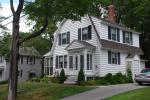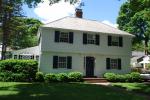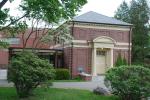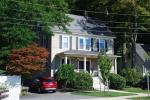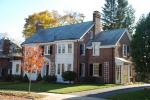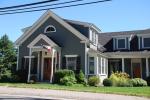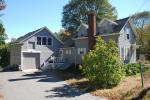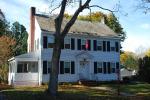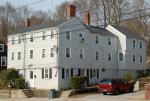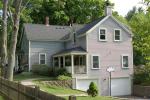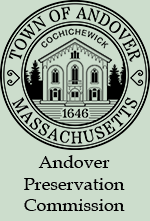Researching the history of your house in Andover, MA
Researching your home history is like building a family genealogy. Begin with what you know about your house from the time you purchased it. Write down any previous owners and related stories passed on to you by your realtor, neighbors and former occupants. Use these notes as a beginning reference as you explore primary resource materials. The following lists are good places to find information about your house.
Andover Assessors office
Andover - Memorial Hall Library- Andover Room, website, directories
Andover Center of History & Culture- formerly Andover Historical Society
Northern Essex Registry of Deeds in Lawrence
Essex County Registry of Deeds in Salem, MA
Peabody - Essex Museum Research Library, Salem, MA
Massachusetts State Archives in Boston
Haverhill Public Library - Special Collections Room
Newspapers; Andover Advertiser, Andover Townsman, Lawrence-Eagle Tribune
National Register Building Survey Inventory
Local Cemeteries; Spring Grove, South Church Burying Ground, West Parish Garden Cemetery, Christ Church Burying Ground, Academy Burying Ground, St. Augustine’s Cemetery, Jenkins-Woodbridge family lot and the Gould family lot.
Ancestry.com; Genealogy, Vital records, US Census 1790-1940, Veteran records
How to begin:
Step one – Deed, book & page - To find the approximate age of your home and past ownership you must do a deed search of the records at the Northern Essex Registry of Deeds in Lawrence (Sept. 1869 to present) and Essex County Registry Deeds in Salem, MA. (1700 – 1870). If you have a copy of your original deed at the time of purchase it will include the Book and Page number of your recorded deed in Lawrence. The Assessors office at town hall also has two sets of books that contain your book and page numbers, one a list by owners and one a list by address. It is also a good time to request copy of your plot plan by map number and lot number (Parcel ID). This map will give the dimensions of your property, square footage and abutters in the neighborhood.
Deed information is now available online via the town website andoverma.gov
Open the Town page
Click – Services and then Assessed Values
In 2020 Property Records – click on Patriot Properties website
Type in your street Name in the box and hit Go
Scroll down to your address number click to open
All your property information is on this page.
Record Parcel ID # - Sale Date and Legal Reference which is your Book & Page #’s or a Certificate # if the property went through land court.
Step two - Registry of Deeds - Northern Essex Registry of Deeds in Lawrence moved to a new location in November 2019. They are located at 1 Union Street, Suite #410, behind the Essex Art Center. All property deeds for Andover, Lawrence, Methuen and North Andover from September 1869 to the present date are recorded here and are contained in books. Recent deeds are all on computer. Original deed books were once all available on shelves but have been scanned and are all online. Deeds are recorded by Grantor, (the seller) and Grantee (the buyer). Deeds give the dimensions of the property, date of sale, all owners, buyers and spouses names, sometimes sale price and almost always the book and page number of the previous owner. Then Record all the grantor and grantee names, book & page and date of sale. Banks often hold the deed until mortgages are paid off but the grantee names are still the legal owners. Sometimes the owner will use his property as collateral to obtain a loan from another individual and transfer the deed over to him. It is then transferred back when the loan is paid back. Some deeds may refer to a Plan number. Record that number information as it will also give a map of your property or the former farm or estate that the neighborhood development was created or sub-divided from.
Online search at Northern Essex Registry Deeds; https://massrods.com/essexnorth/contact/
Open the Registry page
Click – Search Registry and then Search Registry Records
Click Book and Page and then enter the numbers into the boxes and open
Your deed information will appear on the page
Click on the Book Icon below the green bar
Click All pg –View image Online to see the original deed
Look to see if a Map Book Page – PL-# appears with your deed and record that number.
Toggle back at the top of the page on the Rec Land Abstract tab to Modify Search box, click and you return to the Book & Page boxes to enter your new Book and Page numbers and hit Search Records. (This can be a challenge for the first time researcher)
What if a book and page is not referenced in the deed? If this happens during your search there are additional books you can reference to continue through the deed documentation. Two additional sets of books record the Grantors and the Grantees separately in alphabetical order by date of the transaction. Go to the Grantor books first as they cover a larger date reference (1869-1955) than the Grantee books. Both books list date, location and will give the book and page number to the next deed. Once you have reached the last book of your search in Lawrence, if your home is older than 1869, the deed will reference a Book and Leaf number at the Essex County Registry of Deeds in Salem, MA, the county seat.
Things to keep in mind as you read through the deeds. The deed concerns the property transaction and not necessarily your house. Pay close attention to major changes in lot size. This could be a clue that the property has been divided off from a larger lot or estate. Most deeds will state “with buildings thereon” or a certain “message of land” which means with buildings. If neither is mentioned, it does not mean there is no structure on the parcel. It is likely, however, that the property was sold and your home was then built sometime later by the new owner. Houses also burned to the ground, or razed and were rebuilt. You can’t assume that the structure mentioned in your deed is in fact your house.
Construction materials and period styles help with dating a home and do maps. If a map number is given within the deed, record the number and then ask to see the plan. The clerks at the registry will guide you through the use of the computers if the maps have been added to the system. If not, they can provide you with a hard copy. Copies can be made and purchased for a small fee.
Street names and numbering system Streets and roads close to the town or village center were often named quite early in the 19th century but as you travel farther out the roads were often referenced as “the way from Mr. John Smith’s to Mr. James Abbot’s, each living at the extreme ends of the road. Andover finally adopted street names for all roads in 1905. Some road names were changed at this time, such as Mineral St. became Red Spring Rd. and Green St. is now Morton St. Deeds will reflect these changes by stating, Formerly known as…..
Street numbering systems were also adopted with the numbers increasing as you travel away from the town center. Odd numbers were assigned to houses on the right and even numbers to the left in most cases but not all. In 1959 it was necessary to renumber most houses in town as lots began to be subdivided especially in West Andover. Some changes were dramatic such as #183 Argilla Rd is now #93. Don’t assume the resident moved, only the number was changed.
What if my house was moved to the property? Deeds only follow the land and not the structure. Deeds do however mention land “with buildings” at the time of sale. If your deed no longer states “with buildings” it is likely that your house was either built at this time or moved to the lot if the house is from an older period. Moving structures was a common practice in 18th and 19th century New England. Moving a major structure however would have been an event and possibly written about in a local newspaper. Often a brief news line may state, Mr. Smith has purchased the former James Abbot house and relocated it to his new lot. Now you have the former owner name. Maps and deeds can reveal where Mr. James Abbot lived.
Units of Measure - Units of measurement in land surveys have changed over the years. Feet and inches are most common in late 19th and all 20th century deeds. Earlier deeds used the archaic British system using rods, poles, links and chains. A rod is equal to 16.5’ and a link is 7.92”. Twenty five (25) links equal 1 rod. 100 links equal a chain which is 66’. A pole is 1 square rod Copy the first deed you encounter with the measurement change to use it as a reference as you continue your search. The further back you go in years the less accurate the deeds become. Reference points can be trees, rocks, fences, and buildings that have long since disappeared. Keep notes on abutter’s names and total acres included within your property to make sure you are continuing on the right property. Best advice, don’t try to convert the measurements just familiarize yourself with them and keep an eye out for major discrepancies.
Essex County Registry of Deeds, Salem, MA: The Salem Registry of Deeds contains all recorded deeds for towns in Essex County and is located at 45 Congress St., Salem, MA. All Probate records remain in the old courthouse building. The deeds from 1640 to 1869 for Andover are digitized and available online through the Salem, Southern Essex County website. The lowest number currently on the shelves was #100 which includes the year 1754. All earlier deed books from the 1600’s to 1750 have been transferred to the Massachusetts State Achieves Building at Columbia Point in Boston, located across the street from the Kennedy Library.
http://salemdeeds.com/salemdeeds - Their webpage is set up differently from the Lawrence site and easier to navigate. Open site, hit Searches tab on left, choose Search Our Records, hit Book & Page Search and enter the numbers, hit Document Info. All early deeds refer to pages as leafs which are actually two open pages and numbered accordingly. Use the green arrows at the top of the page to scroll forward or back until you find the names mentioned in your deed.
Probate Records in Salem – Essex Probate and Family Court; located at 36 Federal St. Salem. Personal wills are a great way to find out more about family and relationships. If a person dies intestate, (without a will) or defaults on a mortgage, the court is required to settle the estate. A complete inventory is done of all personal property and real estate. Alphabetical indexes by date of death are located in books in the Probate office and have been digitized. Early records have also been relocated to the state achieves. Historic Probate Records are searchable via familysearch.org. or through Americanancestors.org New England Historic Genealogical Society for free if you sign in as a guest member.
Federal & State Census Records - A search of Federal and State census records will give all family members living at your address during that year. The First Federal Census began in 1790 and continues to this day, once every ten years. 1940 is the latest available year. Included in the records will be age, occupations, place of birth and marriage status. Sadly all the 1890 Federal census records were destroyed in a fire. The Library has a membership available for research. Haverhill Public Library has the census records on microfilm. Call ahead for the hours of the Special Collections room.
Street Lists & Directories -Town Street Lists and Directories are another great resource to locate family members and occupations. Both the library and the History Center have copies of directories which were published every other year from 1885 to the 1940s and every year since 1948.
Tax Evaluation records - Tax evaluation records from 1850 through 1920, published every ten years give a wealth of information on individual personal property, number of acres owned, building values of houses, barns and other structures on the property.
Vital Records - Town Vital Records on microfilm at the library give birth, death and marriages from 1650’s through the early 20th century. Published books contain the same data from 1660 to 1850 are also available for research.
Newspapers - Local newspapers often publish lengthy obituaries or obsequies on prominent town residents and can give vital family member information to aid in your research.
Cemeteries - The town’s Spring Grove Cemetery established in 1871, burial records are available online as is the South Church burying ground est. 1712. West Parish Garden Cemetery also has a website and the superintendent there is always accommodating. Website Find-A-Grave has done some surveys of Andover’s cemeteries.
Maps- Maps are also a good source to locate owners of your property. Andover has published maps of 1830, 1852, 1855, 1872, 1882, 1888 and 1906 that contain owners’ names and house location on the map. Several newer maps have also been published but no longer contain individual marked property but do list new streets and developments.
Collections - The Andover Center of History & Culture Historical has a large collection of research on historic houses in town. The achieve includes an extensive photographic collection of individual homes and streets in town. A check of the files in Past Perfect at the Center by street and house number could provide you with a period photo of your home. Be sure to check the files of villages of Andover too. Once you have the former owner names look for individual family files of genealogies and photographs.
Memorial Hall Library online digital collection has all local newspapers available on their website. Town directories, family genealogies and all town meeting records and school reports are digitized and in bound volumes available through the reference desk. Computer terminals are available to guide you to the local town websites and cemetery records.
Dating your house. - Finding the exact date that your house was built is perhaps the hardest fact to uncover in all the research. Deeds can lead to an approximate year but unless you uncover a recorded contract between the builder and owner or a deed that specifically states when the house was built, use the prefix Circa before the date. Period and style of the home will give you a general clue as to the time frame. If you are lucky to uncover a beam or board with a date and name on it you will truly be a fortunate home owner. There is also a scientific approach called dendrochronology. Core samples from beams in your home are taken and sent to a lab for examining the growth rings. From a library of 350 years of growth rings accumulated from virgin forest trees in the region, lab technicians can calculate to within a few years as to when the tree was cut from the forest to build your house. This is however a costly method and may not produce the desired date that was claimed to be the age of the house, but it is accurate.
Creating a story about the families who lived in your home. - Once you have completed the deed ownership genealogy you now have a list of the families who have owned and most likely lived in your house. Properties were sometimes rented out too or boarders taken in for extra income so don’t be dismayed if the surnames don’t match up with the owner. Record the people as they may be relatives of the spouse. As you gather more information about each family, from the sources listed above, a story will begin to emerge. Please substantiate your findings with references and sources. Don’t assume information through conjecture without the facts to back it up. Family histories and traditions handed down can be useful tools, but may also be filled with misinformation and myths that are just not accurate. Stick to the proven facts. If you debunk a myth while doing the research, state the myth and the facts that dispute it. If you assume something to be true or false state your assumption but let the reader know.
Keep your work organized in a binder for easy access. You are now the stewards of your property. Most of all have fun while doing the research and don’t forget to include a brief history of your family. If you have made renovations explain what was done and when it was completed so future generations will understand the evolution of the home.
Applying for a Historic House plaque
The historic plaque program for houses in Andover began in 1990 as a way to visually recognize homes in town with historic significance. We hope they will also serve as a way to educate the public as to how a date reflects a period of style in home construction.
Plaques are issued by the Andover Preservation Commission through the Andover Center of History & Culture. Fill out an application form and present a copy of your house research. It should include the following;
Complete the Massachusetts Historic Building survey form
List all former owners beginning with the most current.
List deed, Book & Page and the date of sale
A copy of the earliest deed uncovered. With book and page clearly marked.
Deed location Lawrence or Salem, MA
Include a brief paragraph on the historical information of the families that have resided in the house.
Historical significance of structure besides residence, if any (former tavern, doctors office, schoolhouse, barn, etc)
A list of resources that substantiate your research
Applying for a Historic House Plaque
See this page on the Historic Building Marker Program.
